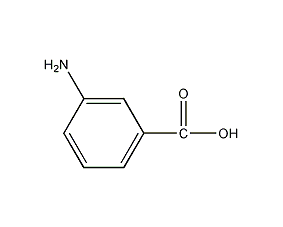
Structural formula
| Business number | 02F3 |
|---|---|
| Molecular formula | C7H7NO2 |
| Molecular weight | 137.14 |
| label |
3-aminobenzoic acid, 3-Aminobenzoic acid, Benzamine acid |
Numbering system
CAS number:99-05-8
MDL number:MFCD00007795
EINECS number:202-724-4
RTECS number:DG1225000
BRN number:471603
PubChem number:24847793
Physical property data
1. Properties: White or light yellow needle-like crystals, sweet taste.
2. Density (g/mL, 20/4℃): 1.5105
3. Relative vapor density (g/mL, air=1): Undetermined
4. Melting point (ºC): 173~174
5. Boiling point (ºC, normal pressure): Undetermined
6. Boiling point (ºC, 30mmHg): Undetermined
7. Refractive index: Undetermined
8. Flash point (ºC): 150
9. Specific rotation (º): Undetermined
p>
10. Autoignition point or ignition temperature (ºC): Not determined
11. Vapor pressure (mmHg, 20ºC): Not determined
12. Saturated vapor pressure (kPa, ºC): Undetermined
13. Heat of combustion (KJ/mol): Undetermined
14. Critical temperature (ºC): Undetermined
15. Critical pressure (KPa): Undetermined
16. Log value of oil-water (octanol/water) distribution coefficient: Undetermined
17. Explosion upper limit (%, V /V): Undetermined
18. Lower explosion limit (%, V/V): Undetermined
19. Solubility: Slightly soluble in cold water, cold alcohol and cold chloroform, easily Soluble in acetone, soluble in boiling water, hot ethanol, hot chloroform and ether, but insoluble in benzene and gasoline.
Toxicological data
Acute toxicity: Mouse oral LD50: 6300mg/kg; Mouse peritoneal cavity LDL0: 500mg/kg; Wild birds oral LD50: 750mg/kg.
Ecological data
This substance is harmful to the environment, and special attention should be paid to the pollution of water bodies.
Molecular structure data
1. Molar refractive index: 37.41
2. Molar volume (cm3/mol): 104.2
3. Isotonic specific volume (90.2K ): 295.2
4. Surface tension (dyne/cm): 64.3
5. Dielectric constant:
6. Dipole moment (10-24cm3):
7. Polarizability: 14.83
Computational ChemistryData
1. Hydrophobic parameter calculation reference value (XlogP): 0.1
2. Number of hydrogen bond donors: 2
3. Number of hydrogen bond acceptors: 3
4. Number of rotatable chemical bonds: 1
5. Number of tautomers:
6. Topological molecular polar surface area (TPSA): 63.3
7. Number of heavy atoms: 10
8. Surface charge: 0
9. Complexity: 136
10. Number of isotope atoms: 0
11. Determine the number of atomic stereocenters: 0
12. Uncertain number of atomic stereocenters: 0
13. Determine the number of chemical bond stereocenters Number: 0
14. Number of uncertain chemical bond stereocenters: 0
15. Number of covalent bond units: 1
Properties and stability
1. Avoid contact with strong oxidants, strong acids, and strong alkali.
2. Irritating.
Storage method
Store in a cool, ventilated warehouse. Keep away from fire and heat sources. Protect from direct sunlight. The packaging is sealed. They should be stored separately from oxidants, acids, and alkalis, and avoid mixed storage. Equipped with the appropriate variety and quantity of fire equipment. Suitable materials should also be available to contain spills.
Synthesis method
1. Catalytic hydrogenation of nitrobenzoic acid. Dissolve m-nitrobenzoic acid in water, heat it to below 70°C, and adjust the pH value with 10% liquid alkali to make the pH value greater than 7. Add 2% activated carbon, decolorize for 20-30 minutes, and filter. The filtrate was adjusted to pH 8-8.5 with 10% liquid caustic soda. Add palladium carbon to the filtrate (obtained by slowly adding 2% palladium chloride solution into a pot of water and activated carbon, stirring while adding, and then passing hydrogen gas after adding), heat to 40-45°C, and pass hydrogen until no more Until more hydrogen is absorbed. Filter off the palladium carbon to obtain sodium meta-aminobenzoate solution. The yield is 95%. Nickel can also be used as a catalyst. The test results show that the yield is 99.8%; add 88% m-nitrobenzoic acid (according to 100% 82.3g) and 400ml water into a 1000ml beaker, and adjust the pH to 6 with 22% sodium hydroxide. -7. After the material liquid is completely dissolved, add 17g of Raney Nickel, pump the material liquid into the swing autoclave under stirring, replace it twice with hydrogen and nitrogen respectively, and then pressurize it to 3.92MPa, at a pressure of 2.94-3.92 MPa, the temperature is 130-140°C, the reaction is about 5 hours, and the end point is when the hydrogen pressure does not drop. After filtering and drying, the finished product is obtained. 2. Iron powder reduction method: Add water, hydrochloric acid, and sodium chloride to the reaction tank and raise the temperature to 80°C. Add iron powder, keep at 95°C for 30 minutes, add m-nitrobenzoic acid in batches, keep at 100°C for 1 hour, cool to 80°C, and neutralize with sodium carbonate to pH above 9. Press filter at 50°C and wash the mud with water to obtain a light brown reducing liquid. Use hydrochloric acid to adjust the pH value, or use salting-out method to precipitate m-nitrobenzoic acid, and then filter and dry to obtain the finished product. The yield is 90%.
Purpose
Mainly used in the pharmaceutical industry and dye industry. It is an intermediate in the manufacture of azo dyes, iodobenzoic acid and cholecystic acid. It is also a reagent for measuring copper.

 微信扫一扫打赏
微信扫一扫打赏

